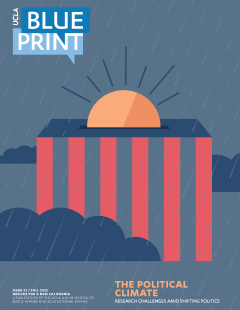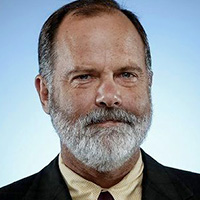Senator Alex Padilla is a working-class kid from Pacoima who grew up to represent his own neighborhood on the Los Angeles City Council. He’s the son of immigrants and a graduate of the Massachusetts Institute of Technology. His career has been both methodical and charmed: He was drawn to politics in part because he was revolted by vitriol directed against illegal immigrants during the debate over California’s Prop. 187 in 1994, and he became the first Latino ever to serve as President of the L.A. council. Many Angelenos got their first good look at him in 2001, when Mayor Jim Hahn happened to be out of town on Sept. 11, leaving Padilla briefly in charge of the city government during the days immediately following that American catastrophe.
Twenty-three years later, he has continued his march up the California political ladder, serving in the state senate, as secretary of state and now in the United States Senate. Deliberate, thoughtful, analytical, Padilla rarely is at the center of hot controversy, but that’s precisely where he landed last summer, when he crashed a news conference by Homeland Security Secretary Kristi Noem and was wrestled to the ground by security. It was, for many, a pivotal moment, one of L.A.’s most recognizable figures shoved to the floor for standing up for immigrants. Then, to add insult, Vice President J.D. Vance dismissed the confrontation as a stunt and called Padilla “Jose.”
Padilla and Blueprint editor-in-chief Jim Newton met last month at the U.S. Capitol, where they discussed climate change — an abiding issue in the senator’s career — as well as the state of the nation under Trump. The interview is presented here in two pieces. Below, their conversation about the climate and climate policy. Their conversation then went on to explore Padilla’s incident with Noem and its aftermath; the audio of that portion may be found here. The interview has been edited for length and clarity.
BLUEPRINT: How serious and imminent is climate change in the lives of Americans today?
SENATOR ALEX PADILLA: Climate change is more than just a clear and present danger. You can point to extreme weather events and their increasing frequency and severity across the country — tornadoes in Kentucky when it’s not “tornado season,” hurricanes in Florida, flooding … but I do think California is Exhibit A for climate change not being a threat or concern for the future, but for it being here and now.
BP: Have leaders in California done enough to prepare for it? Are we doing enough now, as we speak?
AP: We have certainly leaned into it. We have set a great example for the rest of the nation to follow. My first four years in the Senate, under President Biden … the bipartisan infrastructure law, the Inflation Reduction Act, included a lot of elements that I was able to advocate for by pointing to the California experience and success, our shift to renewable energy.
Some of that is based on the work I had the pleasure to do when I was in the state Senate, chairing the Energy Committee. Clean technologies in general, water efficiencies, energy efficiencies and beyond. Climate change isn’t just about trying to have a more efficient grid. That’s important, too. But reducing the emissions to try to mitigate the impact on weather patterns, whether it’s prolonged droughts or atmospheric rivers, or wildfires, of course. And what it means for jobs, food supplies, etc.
And this was long before the fires of this January. Just to touch on those for a second: For all the response to that — I had colleagues from both sides of the aisle approaching me, asking “How’s it going?” “We’re sorry. It seems horrific” — the biggest fact was that it was January. It wasn’t the hot, dry summer months. That should be the latest wakeup call for everybody.
BP: If you were coming to this cold, you would ask yourself, “Why is there a partisan divide on this issue?” This is an issue of science. It universally affects people. There is no red-state version of climate change versus a blue-state version. Do you have an explanation for why this is as partisan as it is, other than that fact that everything seems to be these days?
AP: It’s the times that we’re living in. Look, no doubt there’s the influence of lobbies, It’s the fossil fuel companies on one side and on the green side, there’s varying degrees of righteousness.
But the work is too important to just give up and say it’s impossible because it’s just too divided right now.
When I first got here in 2021 … the electrical grid in Texas was taken out by an ice storm [Note: A series of storms in February of 2021 caused the state’s power grid to fail, leaving 4.5 million people without power and costing the lives of more than 200. Texas Governor Greg Abbott initially blamed the grid failure on renewables, but that was proven false. The bulk of the failure was caused by inadequate winterizing of natural gas infrastructure]. That was an opening for me. I approached Senator [John] Cornyn at the time. I said, “Look, John, I’m not here to give you grief. It’s only a matter of time before wildfires threaten the grid in California. There has to be something we can do together.”
And so we put our heads together and had the explicit conversation about not using the term “climate change” in the title. But as long as we got the … policy right, we knew we could make an impact. We had the audacity to pitch our colleagues on the idea of [spending] a billion dollars to work with states and utilities to modernize the electrical grid, to have a more resilient grid. As we shopped it, not only was it embraced on both sides, but it got swept into the bipartisan infrastructure law with just one change: Instead of a billion dollars, we got $5 billion. And that obviously got signed into law.
That’s one example. I’m not saying things are always easy. In fact, they are always very hard. But they’re too important to give up on.
Now if we can just replicate that. More on the electrical grid, more on water, more on infrastructure in general, building with more resilience.
BP: What role does research play in your work? Are you confronting technical obstacles or political obstacles, both? And how do you draw upon research to help you deal with these questions?
AP: Research is fundamental. And granted, I’m one of the few engineers serving in the Senate, so my problem-solving process always begins with: What’s the data? What are the knowns? What are the unknowns? And how do we get towards a solution?
That’s one of the reasons I’m heartbroken not just about Trump 1.0 but Trump 2.0. He’s attacking science, literally deleting data sets and … research that informs public policy. That’s a travesty.
And so we look at other partners — state governments, university systems, the private sector — to maintain that research capability until we get better leadership back. That’s true whether it’s climate, whether it’s healthcare, whether it’s cybersecurity. …
BP: If I could ask a related question, are the political problems and the technological problem related, or are they really separate? In other words, is this fundamentally a problem or not having the will or consensus to confront climate change or is it a technical problem? Or both?
AP: It’s not just the technology that’s there …
BP: Because a lot of it is ready, right?
AP: A lot of it is. [Computer] chips, AI, many other examples. And the United States is leading, and a lot of that leadership is based in California. Part of the challenge is not only how do we get ahead, but how do we stay ahead?
Because whether it’s China or other countries, sometimes allies, often adversaries, they’re trying to catch us or get ahead of us. They’re certainly investing a lot into their research and development. And that should be a national security and economic wakeup call for us to continue to invest in research and development here.
BP: Do you think we’re falling behind?
AP: I think we risk falling behind if we don’t maintain our momentum, with dire, dire consequences …
BP: Such as?
AP: Chips as an example. Chips and what they make possible are important not just from an economic standpoint but from a military standpoint. China’s catching up, and we have a choice to make…
Another example: I serve on our National Bio Security Commission. [We look at] emerging technologies, not just at the economic opportunities they present, the health treatments and cures they present … but also at what national security risks it can present if other countries leapfrog us. So it’s important to maintain our global leadership position.
BP: Since Trump took office, the United States has withdrawn from the Paris Accords. The administration has denied California the waivers it has historically received in order to exceed the standards of the Clean Air Act. It has directed the EPA not to consider carbon dioxide a dangerous gas. It has linked emergency relief for fire victims to changes in voting rules …
AP: Even the fundamental withdrawal of the endangerment finding [Note: In 2009, the Obama Administration adopted a finding that greenhouse gases pose a danger to the environment, clearing the way for regulations to limit vehicle emissions. The Trump Administration moved this summer to rescind that finding]. The climate rules strike a nerve. I’ve been working on this since my days on the city council in Los Angeles to my days in the state legislature to today.
We know that a disproportionate number of people living in non-attainment areas [areas that do not meet federal air quality standards] in the country live in California, the Central Valley and the Los Angeles Basin in particular. That’s not for lack of leadership and investment by local governments, not for lack of attention, leadership and investment by the state government, but what’s in federal jurisdiction in terms of sources of emissions. That’s where we haven’t made nearly as much progress as we need to.
This Administration and, unfortunately, the Republican majority in Congress, not only haven’t stepped up to do their part but also are tying the hands of state and local government from doing as much as they can to clean the air for the benefit of public health but also the economy.
BP: Sorry to beat a drum about this, but it’s hard for me to see where the opposition to this comes from? Why does anyone of any ideology object to cleaner air and economic growth…
AP: Well, there’s the old adage: Follow the money. What industries and what interests stand to lose as California and others across the country and across the world move toward a cleaner energy economy? It’s not a surprise there where a lot of the lobbying money and efforts comes from
Number Two is politics. I know Donald Trump has it in for California in a big, big way. But I’ve also been hearing from Republicans for years about those “California values” or more specifically “San Francisco values” when they tried to demonize Nancy Pelosi and her leadership.
When you really stop and look at the California success story — the most populous state in the nation, the most diverse state in the nation, home to more immigrants than any state in the nation. That’s the same California that’s become the fourth-largest economy in the world. Not despite our diverse population. Not despite our immigrant population, but because of their contributions.
It’s Donald Trump’s worst nightmare. We’re proving the opposite of what he stands for. The California example, not that it’s perfect, but there’s a lot to respect about it. It should be something to be replicated and built on, not demonized or attacked.
BP: I can remember when the conventional wisdom was that you could have economic growth or environmental protection but not both. Is that still true? Or was that ever true?
AP: I don’t think that was ever true. We can and must have both. They are not mutually exclusive. They are co-equal goals.
BP: And co-achievable goals?
AP: Yes, and co-achievable goals.
And don’t just take my political or policy word for it. Look where a significant amount of venture capital is being invested. California is home to most of the venture capital funding in the country. It’s also home to a lot of these clean-energy tech startups.
And that’s not a coincidence. It’s because of California’s policy leadership, whether it’s setting the goals for emission standards for passenger vehicles or setting the bar for renewable energy or setting the bar for how we use hydrogen.
BP: What would you say to a scientist or researcher today who is concerned about climate change and also interested in being funded, working in an environment where the Administration is so hostile to the very idea of climate change? Is there a way to be a responsible researcher and a funded researcher?
AP: Keep the faith. Stay true to the values of why you are doing research. The political pendulum swings back and forth, sometimes a little too quickly, sometimes not quickly enough, but what drives us in the long term is that fundamental research.

























